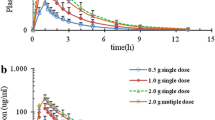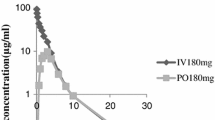Summary
After administration of ceftazidime as a 1 g i.v. bolus injection, its concentration was measured by HPLC at frequent intervals in serum, bile and tissue from different parts of the biliary tract in 32 patients undergoing operation for biliary tract disease. In bile from the functioning gallbladder and common bile duct, a high concentration of ceftazidime was found, mean 18.5 and 26.6 mg/l, respectively. In bile from the non-functioning gallbladder, a very low concentration was found (<1.5 mg/l). Ceftazidime in the gallbladder wall varied considerably with the type and degree of inflammation judged histologically; the mean level was 21.3 mg/kg. The elimination half-life of ceftazidime was 1.74 h, apparent volume of distribution 20.01 and total plasma clearance 133 ml/min. In bile from T-tube specimens a high concentration was found, the mean peak values being 27.2 mg/l. However, biliary excretion of the drug was low at less than 0.5% of the administered dose. These concentrations of ceftazidime were sufficient to inhibit the in-vitro growth of pathogens, namely theEnterobacteriaecae commonly responsible for biliary tract infection.
Similar content being viewed by others
References
Ayrton J (1981) Assay of ceftazidime in biological fluids using high-pressure liquid chromatography. J Antimicrob Chemother 8 [Suppl B]: 227–331
Barza M (1982) Pharmacokinetics of antibiotics. In Sabath LD (ed) Action of antibiotics in patients. Hans Huber, Bern, pp 11–39
Cars O, Øgren S (1985) Antibiotic tissue concentrations: Methodological aspects and interpretation of results. Scand J Infect Dis 44 [Suppl]: 7–15
Dawson AM (1981) Infections of the extra-hepatic biliary apparatus. In: Smith R, Sherlock S (eds) Surgery of the gallbladder and bile ducts, 2nd edn Butterworth, London, pp 213–224
Edlund Y, Mollstedt BO, Ouchterlony O (1959) Bacteriological investigation of the biliary system and liver in biliary tract disease correlated to clinical data and microstructure of the gallbladder and liver. Acta Chirurg Scand 116: 461–476
Harding SM, Munro AJ, Thornton JE, Ayrton J, Hogg MIJ (1981) The comparative pharmacokinetics of ceftazidime and cefotaxime in healthy volunteers. J Antimicrob Chemother 8 [Suppl B] 263–272
Harper PB (1981) The in-vitro properties of ceftazidime. J Antimicrob Chemother 8 [Suppl B]: 5–13
Jones RN, Barry AL, Thornsberry C, Gerlach EH, Fuchs PC, Gavan TL, Sommers HM (1981) Ceftazidime, a pseudomonasactive cephalosporin: In-vitro antimicrobial activity evaluation including recommendations for disc diffusion susceptibility tests. J Antimicrob Chemother 8 [Suppl B]: 187–211
Keighley MRB, Drysdale RB, Quoraismi AH, Burdon DW, Alexander-Williams J (1975) Antibiotic treatment of biliary sepsis: Surg Clin North Am 55: 1397–1390
Phillips I, Warren C, Shannon K, King A, Hanslo D (1981) Ceftazidime: In-vitro antibacterial activity and susceptibility to β-lactamases compared to that of cefotaxime, moxalactam and other β-lactam antibiotics. J Antimicrob Chemother 8 [Suppl B]: 23–31
Ratzan KR (1984) Bilary tract. In: Ristuccia AM, Cunha BA (eds) Antimicrobial therapy. Raven Press, New York, pp 455–465
Rowland M, Tozer ThN (1980) Clinical pharmacokinetics. Consepts and applications. Lea & Febiger, Philadelphia, pp 9–76
Ryan DM, Hodges Brenda, Spencer GR, Harding SM (1982) Simultaneous comparison of three methods for assessing ceftazidime penetration into extravascular fluid. Antimicrob Agents Chemother 6: 995–998
Thomas M (1983) Leading article: Antibiotics in bile. J Antimicrob Chemother 12: 419–422
Schoengut H, Jelinek R (1983) Comparative study of the effects of ceftazidime compared with tobramycine plus cefamandole in the treatment of gall bladder empyema. J Antimicrob Chemother 12 [Suppl A]: 219–222
Walstad RA, Hellum KB, Svarva PL, Ingram PM (1983a) The evaluation of ceftazidime in the treatment of bacterial infections in eighty seriously ill patients. J Antimicrob Chemother 12 [Suppl A]: 131–137
Walstad RA, Hellum KB, Blika S, Dale LG, Fredriksen T, Myhre KI, Spencer GR (1983b) Pharmacokinetics and tissue penetration of ceftazidime: Studies on lymph, aqueous humour, skin blisters, cerebrospinal and pleural fluid. J Antimicrob Chemother 12 [Suppl A]: 275–282
Author information
Authors and Affiliations
Rights and permissions
About this article
Cite this article
Walstad, R.A., Wiig, J.N., Thurmann-Nielsen, E. et al. Pharmacokinetics of ceftazidime in patients with biliary tract disease. Eur J Clin Pharmacol 31, 327–331 (1986). https://doi.org/10.1007/BF00981132
Received:
Accepted:
Issue Date:
DOI: https://doi.org/10.1007/BF00981132




